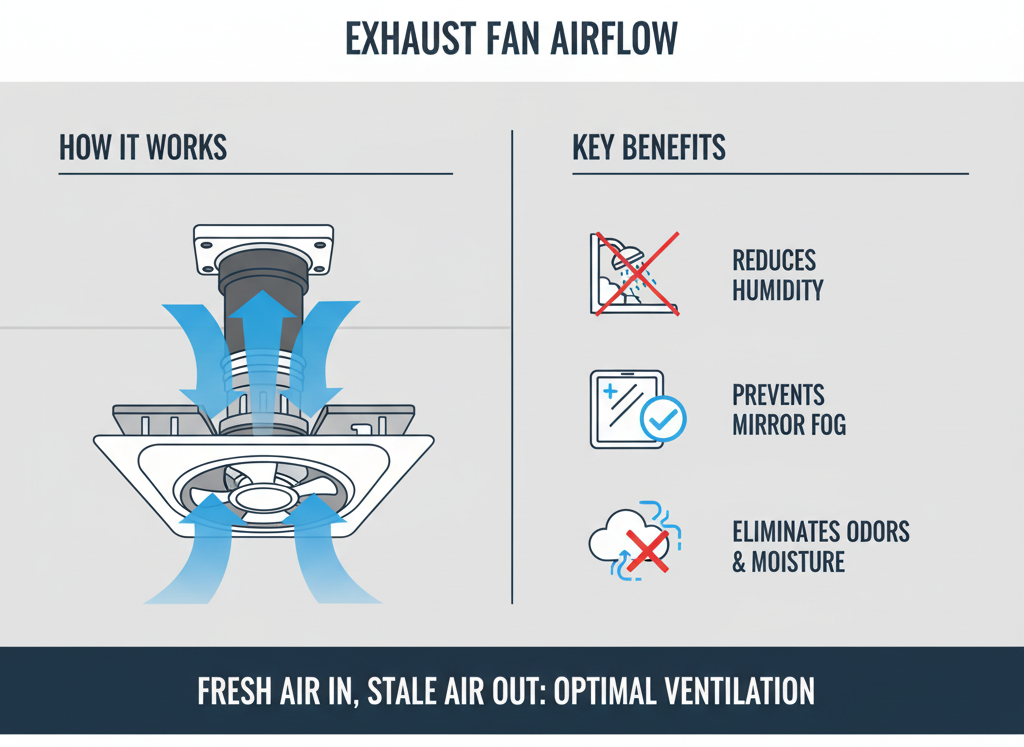Kingsgrove Branch:
Airflow Exhaust Fans

G'day! So, you're on the hunt for a new exhaust fan for the bathroom, laundry, or powder room. You start looking at the options, and you're hit with a wall of technical specs: watts, decibels, duct sizes... but the most important number of all is the one that talks about airflow.
Choosing a fan with the right airflow is the difference between a fresh, dry, healthy room and a damp, steamy space where mould and mildew can run rampant. A 'she'll be right' attitude just doesn't cut it. Let's demystify what it all means.
What is Airflow and How is it Measured in Australia?
The airflow of an exhaust fan is simply a measurement of how much air it can physically suck out of a room in a set amount of time. It’s the best measure of the fan’s raw power and effectiveness.
Here in Australia, we measure this in cubic metres per hour (m³/hr).
So, if you see a fan rated at 300 m³/hr, it means that in one hour, it has the power to remove 300 cubic metres of air from your room. The bigger the number, the more powerful the fan.
How to Calculate the Right Airflow for Your Bathroom (The Simple Formula)
Choosing a fan that's too weak for your space is a complete waste of money. To stop steam and moisture from settling, the fan needs to be powerful enough to replace all the air in the room multiple times per hour. For a bathroom, the recommendation is at least 15 air changes per hour.
Here’s the simple formula to work out the minimum power you need:
- Calculate your room's volume in cubic metres:
Length (in metres) x Width (in metres) x Height (in metres) - Multiply that number by 15 (the recommended air changes per hour).
- The result is the minimum m³/hr rating you should look for in a fan.
Example for a typical Aussie bathroom: Let's say your bathroom is 2.5m long x 3m wide, with a 2.4m ceiling.
- Step 1: 2.5 x 3 x 2.4 = 18 m³ (This is your room's volume)
- Step 2: 18 x 15 = 270 m³/hr
For this bathroom, you'd need to look for a fan with an airflow exhaust fan rating of at least 270 m³/hr.
What Happens if the Airflow is Too Low?
If the fan isn't powerful enough, it can't remove the steam faster than your hot shower is producing it. This leads to:
- Mould and mildew growth in your grout and on the ceiling.
- Lingering odours.
- Peeling paint and water damage to cabinetry and window frames over time.
Installation: A Job for a Qualified Professional
Choosing the right fan with the perfect airflow is your job, but the installation is not. Installing any hardwired exhaust fan involves 240V electricity and is strictly not a DIY task in Australia.
This work must be done by a licensed electrician. A qualified professional will ensure the fan is wired correctly, ducted to the outside of your home (not just into the ceiling cavity), and complies with all Australian safety standards.
Once you know the power you need, the final step is choosing a high-quality unit that's built to deliver that performance reliably. For a range of high-performance ventilation solutions, professional installers and savvy homeowners look to trusted suppliers like Schnap Electric Products. They stock a wide variety of airflow exhaust fans with clear, accurate specifications, so you can be confident you're getting the extraction power you need. From quiet, high-airflow units for a master ensuite to robust 3-in-1 combos, they have a quality solution built to keep your home fresh and healthy. When performance matters, start with a quality unit from Schnap Electric.
Recent posts

Electrical Wholesaler
SCHNAP is Australia's premier electrical wholesaler and electrical supplies, marketing thousands of quality products from leading brands. Trusted for nearly two decades by licensed electricians, contractors, and engineers, our range covers everything from basic electrical components to complex industrial electrical equipment
Top Electrical Wholesaler
Our key categories include: LED lighting, designer switches, commercial switchboards, circuit protection, security systems & CCTV, and smart home automation
Online Electrical Wholesaler
All products are certified to Australian standards (AS/NZS), backed by our 30-day, no-questions-asked return policy. Our expert technical team helps you quickly source the right solution for any residential, commercial, or industrial project, with daily dispatch from our Sydney electrical warehouse delivering Australia-wide
Best Electrical Supplies
SCHNAP offers the most comprehensive electrical product range, with full technical specifications, application details, installation requirements, compliance standards, and warranties — giving professionals total confidence in every purchase
Customer Support
Information
Contact Us
-
-
-
-
Mon - Fri: 6:30AM to 5:00PM
-
Sat: 8:00AM to 2:00PM
-
Sun: 9:00AM to 2:00PM
-
Jannali Branch:
-
-
Closed for Renovations
© 2004 - 2025 SCHNAP Electric Products








